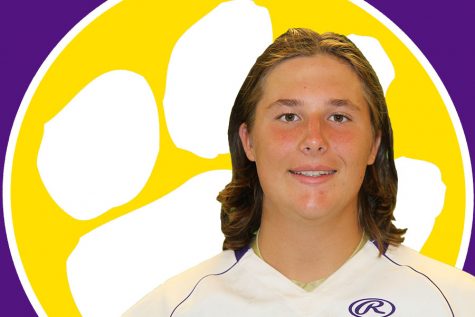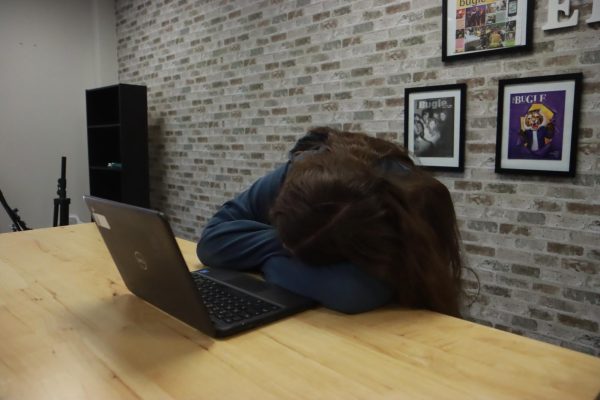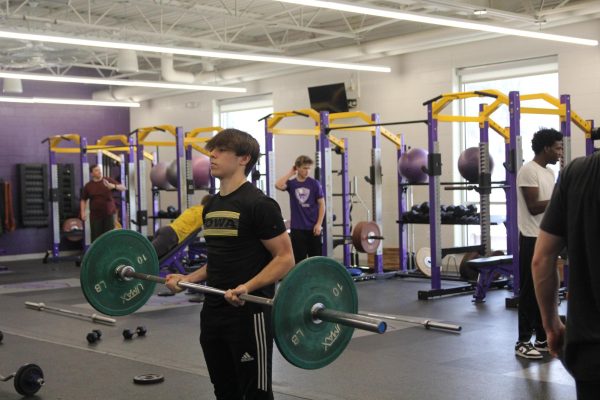1:1: Looking ahead to technology implementation
All high school students will receive a district-issued Chromebook next school year
Typography learned, Emily Holtzmann (11) finishes her project about America on a laptop using Adobe Illustrator in Diana Bashirian’s Graphic Design 1 fifth hour class, Nov. 29. Next year the district will issued a device to each high school student.
The first day of school brought a little upperclassman envy of the freshmen. Rather than have to go to a cart and grab a Chromebook or check in to the library to access a computer, the freshmen whipped out their Chromebooks from their backpacks.
The district distributed Chromebooks to all freshmen at the beginning of the school year.
So far the technology has proven convenient.
“I listen to music on it whenever I need to listen to music, if a teacher says we can,” Cam Martin (9) said. “I use Google Classroom. I use websites for math like ALEKS and Google Docs for papers we have to type.”
ALEKS is a companion site for the high school math textbooks that comes with practice problems.
As soon as next school year, all students will join the current freshmen and receive their own district-issued device. High school students will be the last to join this 1:1 initiative.
All students have the same device definitely has its advantages.
“What I really like is that I’m able to give feedback over a weekend,” Andrew Gensler, Language Arts, said.
“The kid instantaneously has the feedback, instead of waiting until we see each other to give the paper copy with my feedback on it.”
Advanced Language Arts Research/Presentation students were the first to go 1:1 last year.
“[Going 1:1 will] speed up access to different tools and provide ways to differentiate instruction,” Brian Reed, instructional technology specialist, said. “All of those changes ultimately alleviate the burden of leaving classroom space to go to a different location or maybe not being able to because the [computer] lab is booked.”
The high school has experienced an increased access to technology over the past few years.
- Art has two carts of laptops
- Language Arts has one cart of Chromebooks per room for a total of 16 carts
- Math has three cart of Chromebooks
- Science has five carts of Chromebook-like devices
- Social Studies has one cart of Chromebooks per teacher for a total of 18 carts
- World Language has two carts of Chromebooks
And students have been able to bring their own devices to school, as well.
Moving to 1:1 provides an unprecedented opportunity for change in the high school classroom by introducing a personalized learning environment that shifts the dynamic in learning and gives students more ownership.
“It makes doing classwork a lot easier,” Caleb Fitzpatrick (9) said. “I can do it at school and not have to wait until I get home to get on a computer.”
The International Society for Technology in Education outlines five steps for powerfully employing 1:1 in the classroom:
- Learning from others.
- Use the technology you have.
- Let students make choices.
- Choose the best content delivery method.
- Assess as you go.
- Pull it all together.
Moving to 1:1 could be a game changer in the classroom as teachers adapt to the options 1:1 provides: every student having 1) the same device, 2) access to the same resources and 3) the internet available at all times.
Teachers of all-freshman classes are already seeing the difference.
“Google Classroom is where we post everything,” Julianne Varriano, Science, said. “We post video notes. We post PowerPoints, study guides and schedules.”
While Google Classroom is a central location, student learning is taking a different direction.
“In my GeoScience class we use it a lot more for independent work and research based activities,” Varriano said. “I would say my upperclassmen are using them more [for research projects], but I think that’ll change in the next couple years.”
This move should change the role of teacher to one of facilitator as teachers turn the control of learning over to their students. But with so many options out there on the ever-changing landscape of apps and sites, teacher training will be essential otherwise the Chromebooks just remain word processors.
“It can depend on how driven you are to get good grades,” Kamryn Inglis (9) said. “If you want to get good grades, then you use it a lot but there are some that don’t like using them at all.”
On the frontlines of this implementation, teachers are key to meaningful change. Since none of them experienced such a learning environment as students, they may need help with the transition.
Rockwood presented teachers with a few different options for training with the Chromebooks. A technology camp in June 2017 and a ‘Chromebook 101’ session offered teachers information about how to integrate new technology into their classrooms as well as troubleshoot basic issues that come with technology.
“This has been on going and it is not that different from the addition of other devices into their curriculum,” Debbie Ketring, chief information officer, said.
While the technology may not be brand new, the student-wide access is.
Going 1:1 is just one of many changes the district is implementing and yet another factor to which teachers will have to adjust their instruction:
- a focus on developing soft skills
- an increase in student anxiety and depression
- an emphasis on interventions to enhance learning
- a growing number of options for students: the Early College Partnership, dual enrollment, early graduation, tech school, etc.
- the possibility of a new high school program design (story coming)
With everything going on in the district, the students won’t be the only ones learning. The new school year is shaping up to be one that demands teachers pull out all the stops.
Your donation will support the student journalists of Eureka High School - MO. Your contribution will allow us to purchase equipment and cover our annual website hosting costs.

This is Hunter’s second semester on the EHS hub staff. His position on staff is covering sports and managing Sports Center.
You can follow him on...




















